The Abdiel class were six fast minelayers (cruisers) commissioned during the Second World War, built in two groups, one ordered in 1938, the second in wartime and commissioned in 1943. They were known as the Manxman class of just the “mine-laying cruisers”, armed only with defensive artillery, both dual purpose and AA, had a very powerful machinery for 40+ knots escape and three funnels making their silhouette peculiar, or long runs at 38 knots. They also had a wide array of radars not to be surprised underway, and naturally carried a large complement of mines. They were however a bit on the “light” side as cruisers and more comparable to large destroyers, officially referred as minelayers in any case. Speed was a guarantee of survival as they had no protection and had to run deep in enemy waters to lay minefields. This reflected in their heavy losses, half the class in the Second World War and a relatively long postwar service until the early 1970s.
Development
The category of minelayers and the use of mines in general was not in favour in the RN, regarded as a defensive asset best used in restricted waters. Even seeing the Kaiserliches Marine used some minelayers with success in the first world war, so much so this forced the RN to react and built cruisers tailored to intercept them did not budge this position. Minelaying was left to the adversary, whatever it may be. Neither cruisers and destroyers of the RN were equipped to lay mines, unlike for example German and Russian vessels. Perhaps seeing the French launching the dedicated cruiser Pluton in 1933 however reinforced the interest somewhat. Until then the RN only had the HMS Adventure as experiment. She was actually built ten year sprior to the Frenc ships in 1923 and planned in WWI already as a counter measure to German minelaying attempts. Missions in 1918 to min the German bight were led by composite flotrillas with standard minelayers, but speed was very much an issue every time.
HMS Adventure on her part was an adapted C-class cruiser, first built with a transom stern, before it was modified as unsafe when minelaying. She was armed with four 4.7-in Mk VIII QF guns and four 2-pdr Mk.II DP QF defensive AA guns and could carry a massive payload of 280-340 mines. However she was at best capable of 27 knots with a composite steam turbines and diesel powerplant, and this lack of speed was seen later as a considerable drawback. She had however a good range for her size, thanks to her diesels, capable of 4500 nm at 12 knots and still 1800 at 25 knots. But she displaced 8700t fully loaded and thus, was quite large.
So as war was a real possibility in 1938, the Admiralty went back to th prospect of ships designed for the rapid laying of minefields in enemy waters, close to harbours or sea lanes, so a very risky endeavour. As the project went, speciefications were laid up, notably in opposition to HMS Adventure. It was understood that speed needed to be the overriding quality of these ships, to access and extract themselves from enemy waters. Next specifications were precised and it was asserted the need for sufficient anti-aircraft weaponry to defend against enemy aircraft and fast dual purpose guns to deal against coastal patrols, and fast boats. In the end, as the tonnage was compared to power options to reach 40 knots, the objective, the mine load was reduced from 200+ down to 150. And they were to be carried undercover, so inside the hull, like HMS Adventure, for protection and facility. This imposed a tall hull with high freeboard, flush deck. As details were precised mines were to be laid through doors in the stern and on board cranes used for loading.
When plans were approved, the first four were ordered in 1938, and later two more as part of the War Emergency Programme (WEP).
The final layup was more closer to destroyers than cruisers, mostly due to displacement/power/speed constraints.
Design of the class
Hull and general design
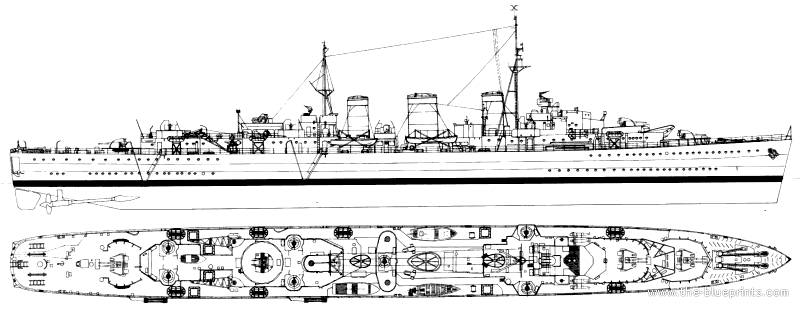
In size and displacement these ships ended as large destroyers, comparable to the Tribal class but with a much weaker armament, whereas their three straight funnels, an instant identifying feature, were closer to cruisers, notably at a distance in bad weather thay could be easily mistaken for County class cruisers, having like them a tall flush deck hull and three funnels, albeit the latter were much thicker and lower. In a sense this was a chance as the latter being heavy cruisers armed with eight 8-inches guns, this could deter a potential adversary, such as enemy destroyer.
The Abdiel class had really a unique design, apart their destroyer size, they were structure more like cruisers with extensive superstructures and the tall, broad hull with two rows of portholes fore and aft, almost constant beam but still fine entries, bulwarked prow like the cruise, a well rounded almost vertical poop for both doors. They also had chutes for two depht charge racks above. In theory they were designed with dual purpose armament under shields which did not took much space and were plmaced in superfiring position fore and aft, before it was revised for more AA. They had a destroyer style bridge typical of the 1939-40 J-K-N classes and fire control posts, then two masts, one tripod mainmast with huff-duff and radars and an aft mast, also tripod, again more looking more to cruisers than destroyers. The three funnels were placed in between. All three were slighly raked unlike masts, and had a wing style profile seen from above, with the central one being broader for twin exhausts truncating.
They had a crew between 242 and 246 for the 1938 group and up to 257 for the war emergency group due to extra AA and radars. They were also considerably modified during the war but it seems kept reasonable stability. They had a low silhouette as well, being more difficult to spot. They carried two powered cutters and a pinnace plus seven rafts. However they were not that roomy due to the internal deck space being taken by mine rails, which ran for most of the hull lenght on two sets of tracks with turns.
Protection was absent, speed their best ally, and standard underwater compartmentation tp separate machinery spaces, turbines and boilers being bulkheaded. The hull bottom was doubled and also contained fuel tanks which can damp a torpedo hit. In this, they were helped by a reasonable draft that could fool an U-Boat thinking the ship is a cruiser.
Powerplant

Top speed was specified fro the start as a blistering 40 knots (74 km/h; 46 mph). Even destroyers were not that fast. In fact nothing was that fast at the time apart Italian “tin-clad” cruisers. To achieve that speed, and despite the size of destroyers, they were given a full cruiser set of machinery with an amazing output of 72,000 shaft horsepower (54,000 kW) on two shafts. To compare the 1937 “Tribals” and their eight main guns displacing 2,520 long tons fully loaded were “only” capable of 36 knots based on 44,000 shp (33,000 kW). Or the Town-class cruisers rated for 80,000 shp (60,000 kW) for 12,980 tons displacement.
Thus, the Abdiels had two sets of large Parsons geared steam turbines fed by four Admiralty 3-drum boilers instead of 2-3 on regular destroyers.
“40” knots was achieved on trials at light load and so contract was honored by all builders, in reality 39.75 knots (73.62 km/h; 45.74 mph) on average, and 38 knots (70 km/h; 44 mph) deep load.
They also carried 690 to 750 tonnes of fuel oil, but this soon appeared unsufficient. Initial range was 1000 nautical miles (1,900 km; 1,200 mi) at 38 knots, so max speed, down to 5,810 nmi (10,760 km; 6,690 mi) at 15 knots (28 km/h; 17 mph). But this lack of range was criticized and the two supplementary ships of the sub-class Apollo had 825 tonnes of oil, which improved the range a bit.
Armament
The ships were initially armed as destroyers escorts despite their size, so purely defensive, with three twin HA/LA Mark XIX mounts and QF 4-inch (100 mm) L/45 Mark XIV guns. Initially four were planned but the need for faster AA had “Y” position removed (superfiring mount aft), only keeping the A-B and X mounts. Both forward mounts had a good a arc of fire. The 4-inches guns were “puny” in comparison of the standard 5 inches of destroyers, but the real appeal was their AA capability and rapid fire.
This was completed by a quadruple “pom-pom” Mark VIII mount, QF 2-pounder Mark VIII placed in a large bandstand located aft of the rear mast and close to its dedicated fire control post in a superfiriong position. There were also two quadruple 0.5-inch Vickers machine guns placed on the wings forward, abeam the bridge.
Acceptable on paper in 1939 this was alrteady less so in 1941 when entering service.
Modifications started right away at the first refit (see below).
The sub-class Apollo of the WEP differed significantly due to wartime experience. It was decided indeed to sacrifice “B” mount and leave only two main twin guns fore and aft, A and X.
Same Mark XVI on twin mounts HA/LA Mk.XIX however. They also had the pompom replace by four 40 mm Bofors twin mounts “Hazemeyer” Mk.IV on Apollo and six on Ariadne, quite a powerful ibcrease in AA firepower to compensate. Two were located in place of “B” mount and two in place of the bandstand, one either side. To topple it off, they also had up to twelve 20 mm Oerlikon on single mounts P Mk.III and/or twin mounts Mk.V. In 1940 both had six 40 mm Bofors on single mounts Mark V “Boffin”, kept long after WW2.
4-inch L/45 Mark XVI
Intended as DP weapon, and reasonably good AAA gun but too weak in anti-ship role. The Mark XVI replaced the 4″/45 (10.2 cm) Mark V HA gun and were mostly assigned on cruisers as secondary caliber. With these however the Abdiels were still vulnerable to German destroyer attacks, especially they would have been eaten alive by the Type 1936A and 1936A(mob) with their 150 mm guns. These were popular weapons and production could not keep up with demand. They were shielded and had a crew of 6-8. These two mounts had an elevation of 70° (not 80°) in all positions. Approximate Barrel Life was 600 rounds.
⚙ specifications 4-in Mark XVI Mount HA |
|
| Weight | 4,495 lbs. (2,039 kg) |
| Length | 190.5 in (4.839 m) oa, 180.0 in (4.572 m) barrel |
| Elevation/Traverse | -10/+80 degrees |
| Loading system | QF breech manually opened, semi auto |
| Muzzle velocity | 2,660 fps (811 mps) or 2,000 fps (610 mps) charge based |
| Range | 19,850 yards (18,150 m) up to 35,000 feet (10,000 m) |
| Guidance | Optical, FCS data |
| Crew | 8 |
| Round | 45.13 in (114.6 cm) HE 63.5 lbs. (28.8 kg)/SAP 66.75 lbs. (30.28 kg) complete |
| Rate of Fire | 15-20 rpm |
Mark VIII mount QF 2-pounder pompom
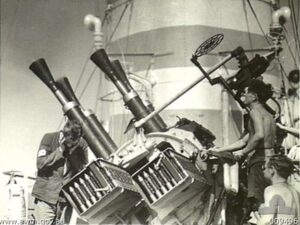 An ubiquitous piece of ordnance on all RN ships in either single, quad or octuple mounts. From 1943 however it started to be replaced by the better performing Bofors on all ships. Shell: 40×158mmR 40 mm (1.6 in), 115 rpm, 732 m/s (2,400 ft/s), 3,960 m (13,300 ft) AA ceiling, range 6,220 m (20,400 ft), using 14-round steel-link belt. Placed on the bandstand aft.
An ubiquitous piece of ordnance on all RN ships in either single, quad or octuple mounts. From 1943 however it started to be replaced by the better performing Bofors on all ships. Shell: 40×158mmR 40 mm (1.6 in), 115 rpm, 732 m/s (2,400 ft/s), 3,960 m (13,300 ft) AA ceiling, range 6,220 m (20,400 ft), using 14-round steel-link belt. Placed on the bandstand aft.
0.5-inch Vickers quad Mk.I
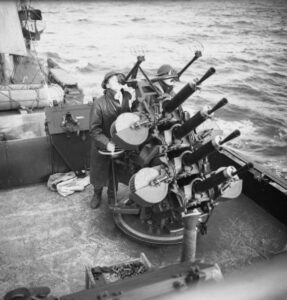 Another standard on RN ships, four barrels placed in tandem with the advantage of compacity. Placed on the wings forward but removed early on in 1942. Fired a 12.7×81mm 0.5 inches (12.7 mm) round (belt fed) at 500–600 rounds per minute, 2,540 feet per second (770 m/s) 9,500 feet (2,900 m) ceiling and 4,265 yards (3,900 m) range.
Another standard on RN ships, four barrels placed in tandem with the advantage of compacity. Placed on the wings forward but removed early on in 1942. Fired a 12.7×81mm 0.5 inches (12.7 mm) round (belt fed) at 500–600 rounds per minute, 2,540 feet per second (770 m/s) 9,500 feet (2,900 m) ceiling and 4,265 yards (3,900 m) range.
40 mm Bofors Hazemeyer Mk.IV
The Hazemeyer was a stabilized naval gun mount for the Bofors 40 mm and later replaced by the STAAG gun mount. it was Manufactured by Hazemeyer in the NL as an alternative prewar to to the QF 2-pounder naval gun, with a set of layers aiming the gun, a second manually stabilized the platform. It was self-contained and stabilized. However it gained a reputation for unreliability.
Full specs 40mm Bofors
40 mm Boffin Mark V
Self contained, fully stabilized mount developed in 1944, in service by 1945. Basically it was a 40 mm Bofors gun mounted on an Oerlikon power mount, and capable of 120 rpm, range 23,300 feet, fitted with Mk II gyro gunsights for accuracy. It stayed in service long after the war.
Mines
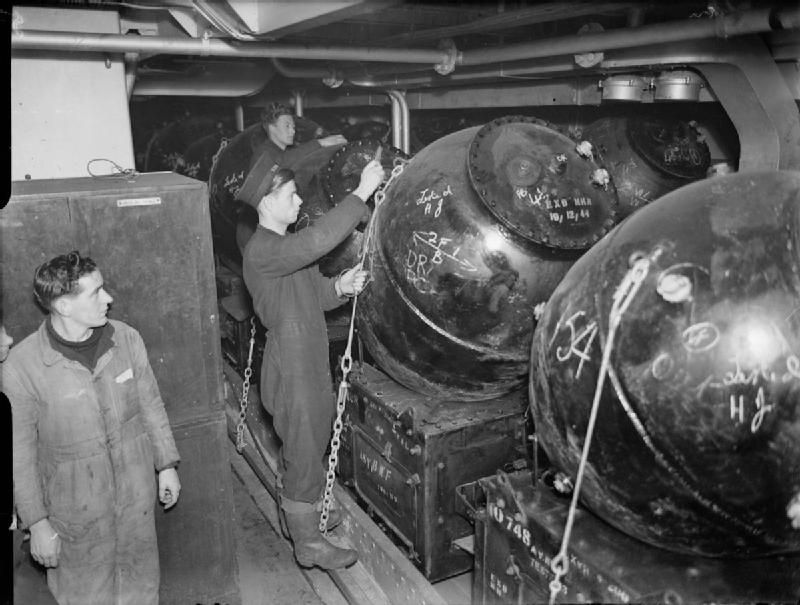
M Mark I mines on board HMS Apollo in 1945 (IWM)
The elephant in the room was their minelaying capability, and they carried all 156 mines.
They could be of the following types:
Moored mines:
-Mark XVII Moored acoustic mine for use against S and R-boats. 7-40 fathoms (13-73 m), 320 lbs. (145 kg) or 500 lbs. (227 kg) WH.
-Mark XX same but with a 60 feet (18 m) upper antenna was 74 feet (22.5 m) lower one. Mark XX* lower antenna only.
-Mark XXII and XXII*: Same as XX but with floating 60 foot (18 m) tubular antenna charge.
-Mark XXV: Snagline mine for S-boats. 40 inches (102 cm) diameter, 4 switch horns, 500 lbs. (227 kg) WH, 15 feet (4.6 m), from 1943.
-Mark XXVII: Snagline version of the Mark XIX (1942).
Ground mines:
-M Mark I: Same as 1920s Mark XV. 146-1,830 m, 500 lbs. (227 kg) charge.
-M Mark III: Former “Type J” magnetic mine with a 1,500 lbs. (680 kg) minol charge. 11-37 m (1941, mod 1942 to 1,600 lbs. (726 kg) amatol/1,750 lbs. (794 kg) minol and with Acoustic triggers in 1943.
Sensors
Type 279: Primitive metric wavelength air warning set, topmast.
Abdiel, Latona, Manxman had the type 286M radar but the last of the 1938 group, HMS Welshman had the type 285 in addition.
HMS Apollo and Ariadne of the WEP program had a brand new suite with the type 272, type 282, type 285, and type 291 radars.
Type 278M: Same 1941 but improved 43 MHz PRF 50rpm, pwd 7–30 μs 70 kW RA 50 nm (93 km; 58 mi) FRq 39.9 wvl 7,450
Type 286: Replacement for the 279 air warning set, FRQ 214 MHz; 200-800 Hz, 2 µs, 6 kW 25 nm (46 km) range
Type 272: Surface search 70 kW FRQ 2950 ±50 MHz S-band PRF 500 pps bmw 8.6º/85º pwd 1.5 μs, 2 rpm RA 1-11 nm (1.9–20.4 km) at 250 yards
Type 291: Ptop mast replacement for 286. 214 MHz PRF 500 Hz pwd 1.1 µs pp 100 kW 35 nm (65 km) res 180 m bmw 40°
Modifications
The first addition was a Type 279 radar at the masthead, later replaced by a Type 286 and then the Type 291, when available. A Type 285 radar set was fitted with a rangefinder-director on the bridge for target ranging and bearing information. The centimetric Type 272 was a target indication radar with plan position indicator (PPI) and it wa sinstalled on the front leg of the foremast.
Armament wise, six single Oerlikon 20 mm cannons on P Mark III pedestal mountings were installed on all ships from 1942-43 when avaiolable and by 1944-45 replaced by twin Mark V mountings. Ariadne and Apollo from the start had twin Bofors Mark IV “Hazemeyer” mountings amidships in place of the pom-poms, dependent of the Type 282 Radar. Ariadne had an extra Hazemeyer mounting in ‘B’ position, replacing the 4-inch guns. In July 1945, Ariadne went in the US to later join the British Pacific fleet ahd received US pattern models Mark I with simple tachymetric directors fitted with Type 282 Radar. All Oerlikon mounts were replaced by Boffin 40 mm AA guns which shared the same mounting.
⚙ specifications *WEP |
|
| Displacement | 2,650 tons standard, 3,415(3,475 tons*) full load |
| Dimensions | 418 ft x 40 ft x 14 ft 9 in (127 x 12 x 4.5m) |
| Propulsion | 2 shafts Parsons GS turbines 4× Admiralty 3-drum WT boilers 72,000 shp (54,000 kW) |
| Speed | 38 knots (70 km/h; 44 mph), max 40 knots light load |
| Range | 1,000 nmi (1,900 km; 1,200 mi) at 38 knots, 5,810 nmi (10,760 km; 6,690 mi) at 15 knots |
| Armament | 6(4*)x 4-in MkXVI, 1×4 2-pdr(4-6x 40mm Bofors*), 2x Vickers quad 0.5 in(12x 20mm AA*), 156 mines |
| Protection | ASW compartimentation |
| Sensors | Type 286M, 285 radars(type 272, type 282, type 285, type 291*) |
| Crew | 242-246(257*) |
The Abdiel class Evaluation
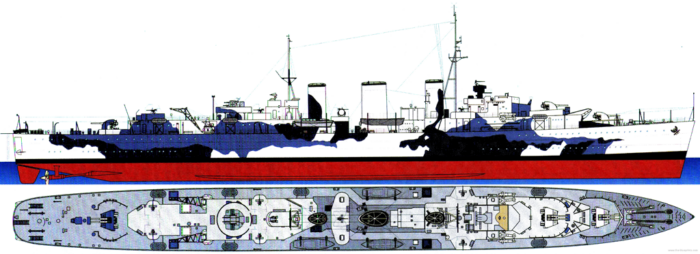
The 1943 livery of HMS Abdiel (the blueprints) 2
This was recoignised as a successful design for what they were in 1941 but were criticized for their low endurance, initially designed for 5,300 miles (8,500 km) at 15 knots (28 km/h; 17 mph) while sea trials showed 4,680 miles (7,530 km) and a sudden drop at high speeds, well below 1000 nm. They were intended to play in the Mediterranean Sea but Admiral Cunningham recommended to fit the nw Apollo class in construction with additional fuel tanks. Like destroyers and unlike cruisers also they had absolutely no armour protection or anti-torpedo bulges. All the space available for their large machinery spaces had limited compartimentation, and could be easily flooded (the bulkhead could simply fail with enough water pressure). The second issue was their undivided mining deck which, if flooding progressed to that level doomed them for rapid rapid sinking.
HMS Adventure compared to the Abdiel and Apollo sub-classw, with mines types and liveryes (Eric Leon, pinterest). See also and this
They were effective ships in their role though, between a generous internal capacity and very high speed meant. This made incidentally perfect as fast transports. And this is why they were used for for most of their career, running supplies, men and matériel to isolated garrisons, Tobruk and Malta during Operation Harpoon in particular. Due to their silhouette they were also played with in their apperance: HMS Welshman was camouflaged to appear like the Vichy French contre torpilleur Tigre, thus intriducing doubts as a target of opportunity for encountered acis submarines and ships or aircraft. This went with a false bow, new funnel caps, mine chutes plated over and to complete this, a false lower deck break was painted. Manxman later had the same disguise to mimick Léopard and approach Corsica, mine Livorno.
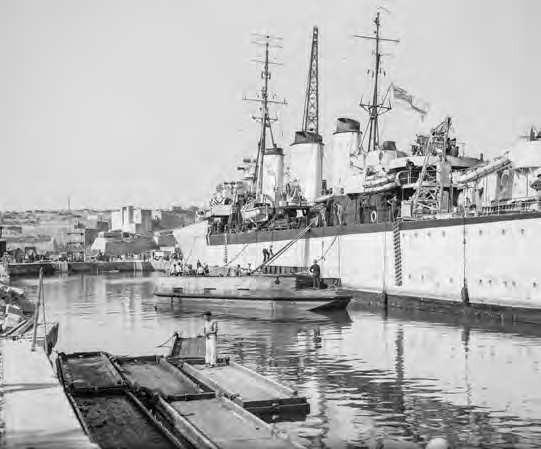
HMS Welshman disguised as Vichy French Le Tigre (IWM)
On her side, HMS Abdiel was painted like a County class cruiser.
There were otherwide to “standard” liveries. Either deck dark grey all over or a mix of light grey for the hull and black in an amidship band in 1945.
But disguise was not enough. On 25 October 1941, Latona was hit by a 250 lb (110 kg) which blasted her engine room, and the fire spread to the munitions, she exploded and sank rapidly. Welshman was torpedoed and sunk by U-617 in 1943 and Manxman was torpedoed, engine room flooded, but amazingly she survived, although in repairs for two years.
Apollo, Ariadne and Manxman survived the war and saw the early colld war. The first eventually became a despatch vessel and Manxman as a mine warfare support ship. In 1953 she mimicked a German raider in the movie based on C. S. Forester’s novel Brown on Resolution.
Career of the Abdiel class
1938 group
 Abdiel (1940)
Abdiel (1940)
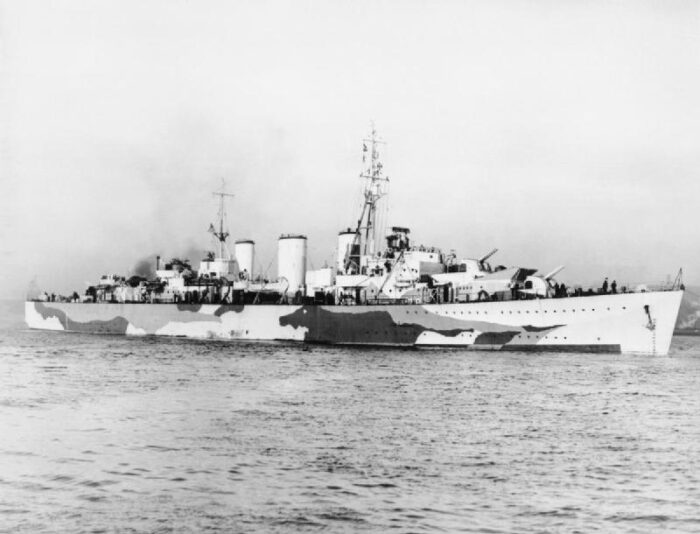
HMS Abdiel was laid down at J. Samuel White & Company in Cowes on 29 March 1939, she was launched on 23 April 1940 and completed on 15 April 1941. On 22 March 1941 under Captain Hon. Edward Pleydell-Bouverie she had trials interrupted when ordered to lay mines to prevent Scharnhorst and Gneisenau breaking out from Brest, in operation ‘GV’, ‘GX’ and ‘GY’, escorted by the destroyers Intrepid, Impulsive and Icarus as wekk as Kipling, Kelly and Jackal on 23 and 28 March, off Little Sole Bank and 40 mi (64 km) WSW of Brest.
From 17 to 30 April 1941 she was ordered to join Dido and the destroyers Kelly, Kipling, Kelvin, Jackal and Jersey to Gibraltar to load military stores for Malta, and so she joined Mediterranean Fleet, still having not completed trials.
On 24-28 April she took part in Operation Dunlop with Dido, Janus, Jervis and Nubian. After Malta they entered Alexandria. On 21 May 1941 Abdiel laid 150 mines off Akra Dhoukaton in the Ionian Sea, whuch claimed the Carlo Mirabello, gunboat Pellegrino Matteucci and German transports Kybfels and Marburg with the 2nd Panzer Division from Patras to Taranto…
On the night of 26–27 May escorted by HMAS Nizam, she landed 800 Commandos at Suda Bay. On 31 May 1941 she sailed to Sfakia with Phoebe and three destroyers to evacuate troops from Crete.
Between December 1942 and April 1943 she operated with Welshman and the minelaying submarine Rorqual to lay 2,000 mines in the Strait of Sicily in several runs.
On 9 January 1943, after she laid a minefield on the axis evacuation route from Tunisia she met the destroyer Corsaro, sank her with other vessels in her group and badly damaged the destroyer Maestrale. On 3 February 1943 her mines badly mauled another Italian convoy south of Marettimo island, Sicily. This claimed the destroyer Saetta and TB Uragano.
On 8 March 1943, same story 30 nautical miles north of Cap Bon in Tunisia. On 24 March it claimed the destroyers Ascari and Lanzerotto Malocello. On 3 April 1943 she laid a minefeld betwen the Italian fields X-2 and X-3 known through Ultra intercepts and documents claiming on 7 March the TB Ciclone.
She met her end on 10 September 1943, during Operation Slapstick. The mines had been laid hours earlier by German torpedo boats S-54 and S-61 as they left Taranto. Abdiel had on board the British 1st Airborne Division, 6th Royal Welch Parachute Battalion and 204 Oban Anti-Tank Battery, Royal Artillery and prepare to land them on the nearest berth but shortly after midnight, two mines detonated beneath her, sinking in three minutes with most of her crew and many of her contingent. Postwar it was believed her degaussing equipment had been turned off to reduce noise for this special operation. But Commander F Ashe Lincoln in “Secret Naval Investigator” (1961), as a naval mine clearance expert believed this was part of a stock of large wooden wheels fitted with depth charges with a timing clock and explosive charge, previously sunk next to the mooring buoy Abdiel used that night. The case is still discussed today.
 Latona (1940)
Latona (1940)
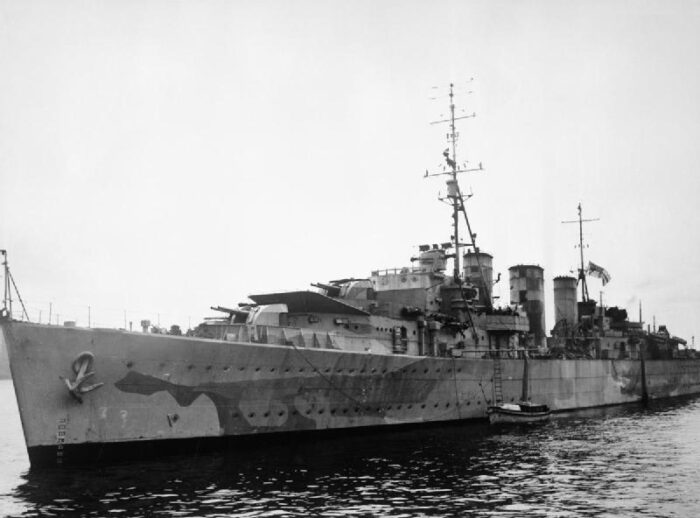
HMS Latona was laid down at John I. Thornycroft & Company in Woolston on 4 March 1939, launched on 20 August 1940 and completed on 4 May 1941. She sailed to Scapa Flow to embark stores and 20 mm AA guns and sailed for the Mediterranean on 16 May via the Cape of Good Hope and Red Sea. She operated from Alexandria on 21 June with Abdiel and went into the same missions, supporting operations in the eastern Mediterranean. Her first assignment was to carry RAF personnel to Cyprus, back to Alexandria on 25 July.
Next she sailed with Abdiel and HMAS Hobart, HMAS Napier and Nizam to support the garrison at Tobruk, bringing in 6,300 reinforcement, evacuating 6,100, mostly wounded. On 25 Octobe they came under air attack north of Bardia and at the time HMS Latona was returning with 1,000 Polish troops on board when hit in the engine room by a Junkers Ju 87 bomb of I./StG1. The fire was soon out of control and reached the ammunition magazine, which detonated. Before it happened, Hero and Encounter came alongside and evacuated most of the troops and crew. She remained afloat for two hours before the detonation. The bomb claimed Four officers, 16 crew members, 7 soldiers.
 Manxman (1940)
Manxman (1940)
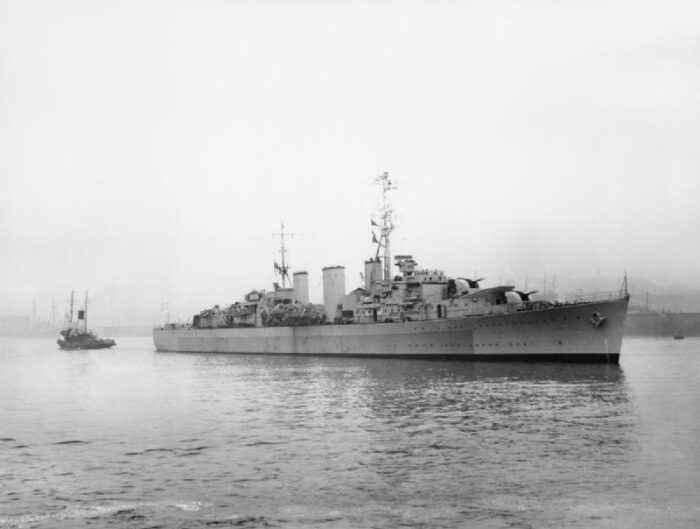
HMS Manxman was laid down at Alexander Stephen & Sons in Linthouse on 24 March 1939, launched on 5 September 1940 and completed on 20 June 1941 (Commissioned 7 June) and her first mission was to carry mines to Murmansk. Next she was transferred to the Mediterranean, for supply runs to Malta. In August she took part in Operation Mincemeat mine-laying in the Gulf of Genoa disguised as the French destroyer Léopard. From October 1941 to February 1942 she was back with the Home Fleet, mine-laying the North Sea and English Channel. In March 1942 she was sent at Kilindini in the Indian Ocean for escort and patrol and supporting the assault on island of Nosy Be, Madagascar (Vichy France) for Operation Ironclad, preluse to the main operation.
Back to the Mediterranean again, she supplied Malta, and mined the Sicilian Channel. On 1 December between Algiers and Gibraltar after Operation Torch, she was torpedoed by U-375, severely damaged but emergency repairs were done so tht she could be towed to Oran and then proceed to Gibraltar, and completed repairs at Newcastle-upon-Tyne.
She was back on 10 April 1945 and schedule to join the British Pacific Fleet but only arrived at Colombo on 14 July, then Melbourne on victory day.
She stayed there until June 1946, was refitted at Chatham and returned to the far East from February to December 1947. Next she was in the Mediterranean Fleet in 1951, impersonating in 1953 the German cruiser Essen for “sailor of the king” with taller funnels and mock-up triple-gun turrets plus fake torpedo damage, filmed in Malta. She took part also of the Fleet Review for the Coronation of Queen Elizabeth II.
In 1956, Manxman she became headquarters ship during Operation Musketeer over Suez. Before getting there, as reported by merchant sailors in the 1970s (pinch of salt here) she out-ran an American Carrier Group after shadowing it. As they reached 30 knots, she accelerated to 38 kts, signalling when passing them the signal “See you in Egypt”. She was refitted in Chatham in 1962-64 converted to a minesweeper support vessel: Forward boiler removed, diesel generators for outboard supply installed, dummy forward funnel housed diesel exhausts and ventilation, mine stowage removed for additional accommodation, recommissioned 1963, stationed in Singapore. Back home in 1968, she served as engineers training ships at Devonport but was devatasted by a fire, placed in reserve at Chatham and BU at Newport in 1973.
 Welshman (1940)
Welshman (1940)
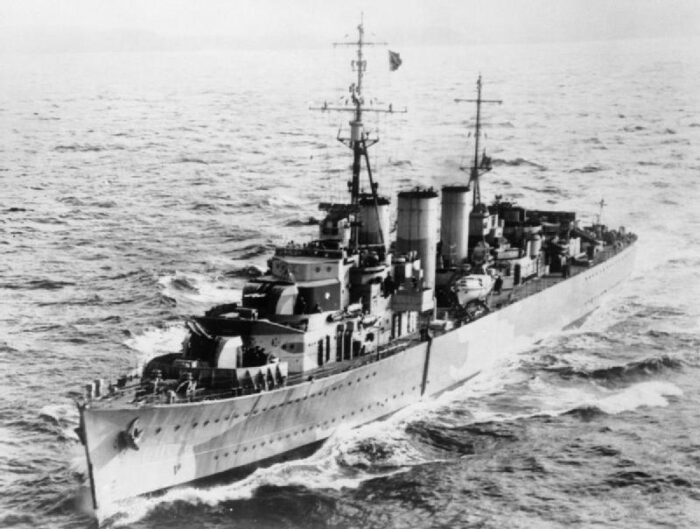
HMS Welshman was laid down at Hawthorn Leslie & Company in Hebburn on 8 June 1939, launched on 4 September 1940 and commissoned on 25 August 1941. First she sailed to Scapa Flow, Home Fleet, assigned to the 1st Minelaying Squadron, Kyle of Lochalsh, for operations in western Scotland and detached in winter for the Bay of Biscay.
In January 1942 she carried supplied to Gibraltar, Freetown and Takoradi. She laid mines in the Strait of Dover in early February waiting for Gneisenau and Scharnhorst in Brest. After refit, she was back in the Bay of Biscay in April. By May 1942 she joined Force H and 8 May sailed from Gibraltar disguised as a French destroyer with 240 tons of stores and RAF personnel for Operation Bowery, entering Grand Harbour, Malta on 10 May and detonating two mines with her paravanes. She was back to to Gibraltar on 12 May, repaired at Yarrows Scotstoun. By 11 June she left Malta for Operation Harpoon. She was detached and unloaded her cargo at Malta on 15 June, then back to the convoy under heavy attack. She went back to Malta with the two surviving merchant ships and escort and proceeded to Gibraltar and UK for another refit.
On 13 July she was back at Force H for Operation Pinpoint to Malta, arriving on 16 July and back to Gibraltar on 21 July.
In August she took part in Operation Pedestal, arriving on 16 August, and sailed for the Eastern Mediterranean by September. In October she returned to Malta with Force H for Operation Train and back to Gibraltar on 2 November. Next she supported Operation Torch. In December she laid mines off Haifa.
In January 1943 she carried supplies to Malta and laid mines in the Skerki Channel (Axis evacuation route from Tunisia) while carrying troops from Beirut to Famagusta in Cyprus.
On 1 February 1943 in a same mission to Tobruk, she was torpedoed by U-617 (Albrecht Brandi). However flooding was gradual thanks to the crew leaving Two hours to evacuate prsonal and troops and she sank east of Tobruk. The torpedoing cost her 155 lives, rescued by destroyers HMS Tetcott and Belvoir, brought to Alexandria.
War Emergency Programme (WEP) group
 Ariadne (1943)
Ariadne (1943)
 HMS Ariadne was laid down at A. Stephen & Sons Ltd on 10 October 1941, launched on 5 April 1943 and commissioned on 12 February 1944. First she laid mines off the coast of Norway and took part in Operation Stonewall. From January 1944 she left for the US for a refit and from there, joined the 7th Fleet in the Pacific. June 1944 saw her laying 146 mines off the northern coast of New Guinea before the Mapia assault of November 1944, and she carried US Army soldiers. She made other missions there, laying 1,352 mines.
HMS Ariadne was laid down at A. Stephen & Sons Ltd on 10 October 1941, launched on 5 April 1943 and commissioned on 12 February 1944. First she laid mines off the coast of Norway and took part in Operation Stonewall. From January 1944 she left for the US for a refit and from there, joined the 7th Fleet in the Pacific. June 1944 saw her laying 146 mines off the northern coast of New Guinea before the Mapia assault of November 1944, and she carried US Army soldiers. She made other missions there, laying 1,352 mines.
Postwar she repatriated British POW from Japan and became mailship. She was paid off, Reserve Fleet, Sheerness, having just a refit and short trial refit in the 1950s and AA upgraded but she was never fully recommissioned again. She was sold for BU to W.H. Arnott Young by February 1965.
 Apollo (1943)
Apollo (1943)
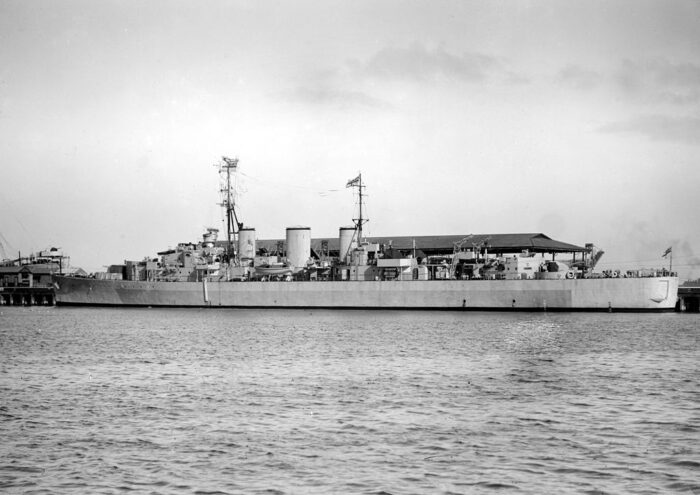
HMS Apollo was laid down at Hawthorn Leslie and Co on 15 November 1941, launched on 16 February 1943 and completed on 9 October 1943. After sea trials in February 1944 she was in Scapa Flow and was sent to lay mines to protect the flank of the Normandy landings operartions, loading mines at Milford Haven and starting laying mines off the Brittany coast between Ushant and Île Vierge.
During Operation Neptune on 7 June she carried Allied Supreme Commander General Dwight D. Eisenhower and Neptune CiC Admiral Bertram Ramsay, General Bernard Law Montgomery and staff officers from SHAEF in a visit of assault areas but grounded while underway. Passengers were transferred to HMS Undaunted. She was repaired in the Tyne until September 1944. Next she was transferred to the Western Approaches Command, and laid mines on the South-Western Approaches to foil U-boat activities inshore. With HMS Plover she laid 1200+ Mk XVII moored mines off the north coast of Cornwall from 29 November 1944 with minefield “HW A1” (claimed U-325), on 3 December “HW A3” east (claimed U-1021).
On 24 December she was sent to Scapa and prepared to lay mines off Norway, Utsira in January escorted by HMS Zealous and Carron.
On 15 January 1945 she mined the Irish Sea. On 13 April she mined the Russian Kola Inlet for Operation Trammel in Force 5 escorted by HMS Opportune, Orwell and Obedient and back in May at Scapa.
In April 1945 she sailed from UK to Oslo with her sister Ariadne and Devonshire carrying the Norwegian Government-in-Exile and Crown Prince Olav back home.
She was prepared to join the British Pacific Fleet, left Portsmouth late June., had exercises in the Mediterranean Fleet, Malta by July, arrived at at Melbourne on 1 August, and soon learning about V-Day.
In 1948 her pennant became N01 and she was decommissioned, then recommissioned in 1951 with the Korean War and joined the 2nd Cruiser Squadron of the Home Fleet. She brough relief to jamaica after Hurricane Charlie on 17 August 1951. In 1953 she was at the Fleet Review for Queen Elizabeth II. By November 1954 she became Flagship CiC Home Fleet. On 25 August 1960 a problem with HMS Battleaxe in steam trials while moored alongside Apollo at Portsmouth, breaking her mooring lines after which she collided with the frigate HMS Wakeful, which broke free and collided with a caisson. Apollo’s stem was damaged. She was eventually paid off, Reserve in 1961, Disposal List 1962, sold for BU to Hughes Bolckow at Blyth, November 1962.
Read More/Src
Books
Tom Brown No 38 Profile Warship. Abdiel Class Minelayers (ii) Jurgen Rohwer “Chronology of the War at Sea 1939–1945”
Very Special Ships – the abdiel class by Arthur Nicholson
Brytyjskie Stawiacze Min HMS Abdiel & HMS Ariadne By Slawomir Brezinski
Caruana, Joseph (2012). “Emergency Victualling of Malta During WWII”. Warship International. LXIX (4)
Nicholson, Arthur (2015). Very Special Ships: Abdiel-Class Fast Minelayers of World War Two. Seaforth Publishing.
Worth, Jack (1986). British Warships Since 1945: Part 4: Minesweepers. Maritime Books.
Links
https://www.navypedia.org/ships/uk/brit_crml_abdiel.htm
https://en.wikipedia.org/wiki/Abdiel-class_minelayer
http://www.navweaps.com/Weapons/WAMBR_Mines.php
http://www.navweaps.com/Weapons/WNBR_4-45_mk16.php
https://www.battleships-cruisers.co.uk/abdiel_class1.htm
https://uboat.net/allies/warships/ship/3953.html
https://www.keymilitary.com/article/go-devil
https://www.shipsnostalgia.com/media/abdiel-class-minelayers.183406/
https://uboat.net/allies/warships/ship/3953.html
https://www.paradata.org.uk/unit/2nd-airlanding-anti-tank-battery-ra
http://www.naval-history.net/xGM-Chrono-07ML-Manxman.htm
http://www.naval-history.net/xGM-Chrono-07ML-Latona.htm
https://uboat.net/allies/warships/ship/3955.html
http://www.naval-history.net/xGM-Chrono-07ML-Welshman.htm
https://web.archive.org/web/20180302075106/http://myweb.tiscali.co.uk/hmsmanxman/page_2.htm
https://archive.org/details/britishwarshipss0000wort/mode/1up
hms ariadne camo 1943 on iwm.org.uk
1/48 yard modek at rmg.co.uk/ Royal Museum Greenwhich
Videos
HMS Abdiel – Guide 207 by Drachinifel
See also in Dr Clarke channel
Model Kits
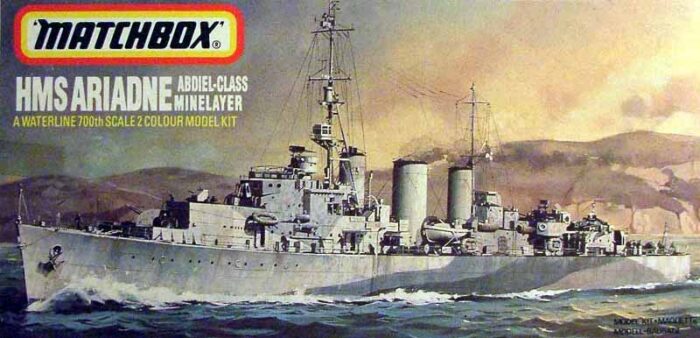
Souvenirs… I made this kit as a kid. Full review
Full serie of models on scalemates
boxartden.com/

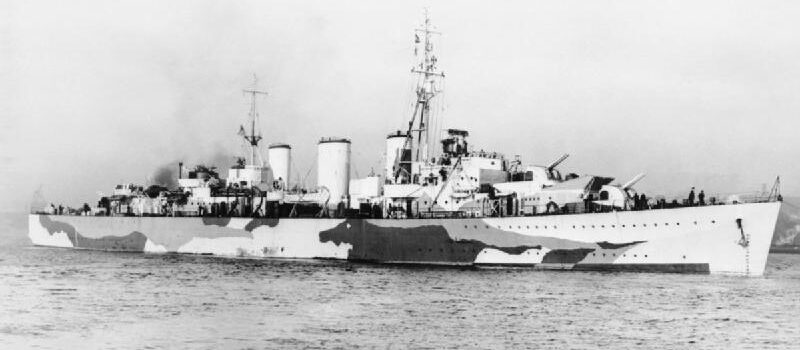

 Latest Facebook Entry -
Latest Facebook Entry -  X(Tweeter) Naval Encyclopedia's deck archive
X(Tweeter) Naval Encyclopedia's deck archive Instagram (@navalencyc)
Instagram (@navalencyc)





 French Navy
French Navy Royal Navy
Royal Navy Russian Navy
Russian Navy Armada Espanola
Armada Espanola Austrian Navy
Austrian Navy K.u.K. Kriegsmarine
K.u.K. Kriegsmarine Dansk Marine
Dansk Marine Nautiko Hellenon
Nautiko Hellenon Koninklije Marine 1870
Koninklije Marine 1870 Marinha do Brasil
Marinha do Brasil Osmanlı Donanması
Osmanlı Donanması Marina Do Peru
Marina Do Peru Marinha do Portugal
Marinha do Portugal Regia Marina 1870
Regia Marina 1870 Nihhon Kaigun 1870
Nihhon Kaigun 1870 Preußische Marine 1870
Preußische Marine 1870 Russkiy Flot 1870
Russkiy Flot 1870 Svenska marinen
Svenska marinen Søværnet
Søværnet Union Navy
Union Navy Confederate Navy
Confederate Navy Armada de Argentina
Armada de Argentina Imperial Chinese Navy
Imperial Chinese Navy Marinha do Portugal
Marinha do Portugal Mexico
Mexico Kaiserliche Marine
Kaiserliche Marine 1898 US Navy
1898 US Navy Sovietskiy Flot
Sovietskiy Flot Royal Canadian Navy
Royal Canadian Navy Royal Australian Navy
Royal Australian Navy RNZN Fleet
RNZN Fleet Chinese Navy 1937
Chinese Navy 1937 Kriegsmarine
Kriegsmarine Chilean Navy
Chilean Navy Danish Navy
Danish Navy Finnish Navy
Finnish Navy Hellenic Navy
Hellenic Navy Polish Navy
Polish Navy Romanian Navy
Romanian Navy Turkish Navy
Turkish Navy Royal Yugoslav Navy
Royal Yugoslav Navy Royal Thai Navy
Royal Thai Navy Minor Navies
Minor Navies Albania
Albania Austria
Austria Belgium
Belgium Columbia
Columbia Costa Rica
Costa Rica Cuba
Cuba Czechoslovakia
Czechoslovakia Dominican Republic
Dominican Republic Haiti
Haiti Hungary
Hungary Honduras
Honduras Estonia
Estonia Iceland
Iceland Eire
Eire Equador
Equador Iran
Iran Iraq
Iraq Latvia
Latvia Liberia
Liberia Lithuania
Lithuania Mandchukuo
Mandchukuo Morocco
Morocco Nicaragua
Nicaragua Persia
Persia San Salvador
San Salvador Sarawak
Sarawak Uruguay
Uruguay Venezuela
Venezuela Zanzibar
Zanzibar Warsaw Pact Navies
Warsaw Pact Navies Bulgaria
Bulgaria Hungary
Hungary

 Bundesmarine
Bundesmarine Dutch Navy
Dutch Navy Hellenic Navy
Hellenic Navy Marina Militare
Marina Militare Yugoslav Navy
Yugoslav Navy Chinese Navy
Chinese Navy Indian Navy
Indian Navy Indonesian Navy
Indonesian Navy JMSDF
JMSDF North Korean Navy
North Korean Navy Pakistani Navy
Pakistani Navy Philippines Navy
Philippines Navy ROKN
ROKN Rep. of Singapore Navy
Rep. of Singapore Navy Taiwanese Navy
Taiwanese Navy IDF Navy
IDF Navy Saudi Navy
Saudi Navy Royal New Zealand Navy
Royal New Zealand Navy Egyptian Navy
Egyptian Navy South African Navy
South African Navy






























 Ukrainian Navy
Ukrainian Navy dbodesign
dbodesign